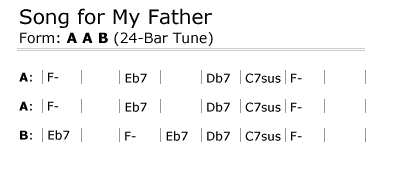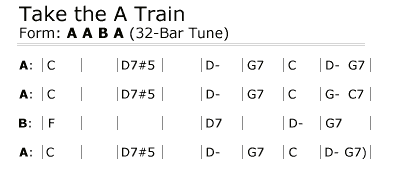V. Form
|
A. Structure
|
|
Most jazz tunes utilize a recurring chord progression that serves as the structure of the tune; the way in which the different sections of the progression are grouped determines the form of the tune. |
|
B. Musical Blueprint
|
|
Form can be considered a tune’s “musical blueprint,” allowing each musician (and educated listener) to keep his/her place in the structure. |
|
C. Sections
|
|
Each different section of a chord progression is assigned a different letter. |
|
|
1. |
for example: if a tune is 24 measures long and is divided into three eight-measure sections with the first two sections containing a set of identical chords and the last section containing a set of different chords, the form is AAB (see Song for My Father10)

|
|
|
2. |
for example: if a tune is 32 measures long and is divided into four eight-measure sections with the first two sections containing a set of identical chords, the third section a different set of chords, and the last section the same as the first, the form is AABA (see Take the A Train)

|
|
D. Chorus
|
|
In a jazz performance, the form of a tune, i.e., all the chords of the tune in a predetermined sequence (such as AAB, AABA, ABAC, etc.), will be repeated over and over; each time through is called a chorus. |
|
E. Common Sequence
|
|
For each chorus, something different happens. The most common sequence is: |
|
|
1. |
first chorus: the melody instruments (e.g., the horns) play the head, that is, the composed melody of the song11
|
|
|
2. |
middle choruses (undetermined number): each musician in turn improvises a solo using the form as his/her guide, knowing the chord progression of each section (the chords provide the impetus for what notes can be played by the improviser); each soloist can improvise for as many choruses as he/she desires
|
|
|
3. |
last chorus: the head again (called the "out" head as the musicians are taking the tune “out,” that is, ending the tune)
|
|
|
|
F. Before and After
|
|
Often before the first chorus (the head), there is an introduction, AKA an "intro;" often after the last chorus (the out head), there is an ending, AKA an "outro." |
|
G. Common Forms
|
|
|
H. Arrangement
|
|
Who does what during each chorus is called the arrangement. |
|
|
1. |
Arrangements can be determined prior to the performance and are often written. Generally speaking, the larger the ensemble, the more need to have written arrangements.12 Arrangements are written and published for jazz bands of all sizes and levels from elementary school to professional. Most are written for the standard “big band” instrumentation of five saxes, four trumpets, four trombones, and four “rhythm,” i.e., piano, bass, guitar,13 and drums (incidentally, most high school jazz bands utilize this instrumentation). More to come on big band music in lesson #4 when discussing the swing era.
|
|
|
2. |
Besides arrangements that are written, simple arrangements can be determined by a brief “talk over” prior to a performance or even on the spur of the moment (this is called a head arrangement). This usually occurs in the small group (quintet or smaller) setting. When occurring at an informal jam session, who does what when is directed by common practice, intuition, and visual cues (e.g., head nods, looks, etc.).
|
|
I. Song for My Father
|
|
|
|
|
Video Clips
|
|
|

